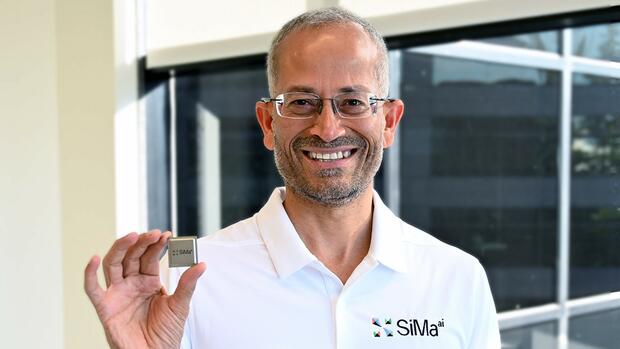Stuttgart Considering the fact that Krishna Rangasayee builds what are arguably the most powerful chips for artificial intelligence (AI), he speaks calmly about his success. “We set out to be a leader in the machine learning industry. Now we have the technical confirmation for this,” says the founder of the start-up Sima.ai. The MLPerf (Machine Learning performance) brought confirmation – a kind of annual chip competition.
Just over four years ago, the now 53-year-old Stanford graduate started Sima.ai. In the most recent performance comparison, its chip performed 50 percent better than Nvidia in terms of speed and power consumption – previously the measure of all things for high-performance chips.
With the new chip, data from cameras can be processed at ten times the speed of conventional AI chips. And that with a significantly reduced power consumption of five watts. This will result in a significant increase in the range of electric cars with high-quality assistance systems in the future. “Sima.ai is a game changer,” confirms Karl Freund, founder and chief analyst at Cambrian-AI Research.
So far, only chip giants have been active in the MLPerf competition – no start-up has ever competed there. Intel, Qualcomm, AMD or, most recently, Nvidia have huge teams for this competition, which only make their chips fit for this test result with complex tuning measures.
Chip for every electronics and sensor environment
“We didn’t tune anything at all, just connected the cable,” says Rangasayee, pointing to a small white box. The chip built into it, including the platform, masters every neural network and AI framework and can therefore also be integrated into any electronics and sensor environment.
Nvidia has always won the competition in recent years. The company’s core business is graphics cards for video games, but the group’s chip sets derived from this were able to achieve great success in data centers and most recently in the automotive industry. Until now, no comparable powerful alternative was available. Hardly any central vehicle computer today can do without processors from Nvidia or Qualcomm. This could change soon.
>> Read also: Why Tesla suddenly shies away from silicon carbide
“We have developed the software and architecture from a single source specifically for AI applications,” explains Rangasayee. The Sima founder has been active in the software and chip industry in Silicon Valley for more than 25 years and owns 25 top-class patents.
He worked as COO at Xilinx for 18 years alone. The IT company was acquired by AMD in 2020 for $35 billion. So far, Sima has raised around $180 million in capital and is already valued at almost $1 billion. Investors of the Californians with around 150 employees include Fidelity Investments, Amplify Partners and Dell Technologies Capital.
The Sima chip has already been delivered to the first customers. These are manufacturers of military drones and robotics. According to the CEO, ramping up production is not a problem, since the world’s largest contract manufacturer TSMC has already made a firm commitment to produce the new chip on its state-of-the-art lines. This also shows how seriously Sima is taken in the industry.
>> Read also: VW and Mercedes let Google and Apple deeper into the car
The new chip is intended to bring about the breakthrough of AI in the “Internet of Things”, i.e. in networked devices. Repurposed graphics card chips do a good job in data centers, but are not necessarily perfect in so-called “edge devices”, i.e. cameras, robots or vehicles. The graphics processors are too expensive and power-hungry for that.
“Sima.ai really established itself right from the start with a fully functional chip and is the start-up of the hour for edge devices,” said Kurt Keutzer, professor at UC Berkeley and authority in the field. So-called edge solutions should be able to control cars more safely and conveniently, for example – directly in the vehicle, independent of data streams via the cloud.
Game changer in the battle for the robot car
The Sima founder has won over the ex-top manager at Mercedes and Bosch Harald Kröger as a door opener for the automobile market. “With the user-friendly chip, automotive suppliers don’t have to hire an army of AI specialists before they can get started,” says Kröger.
German experts see potential for Sima. “A key to market success is the software element,” says Peter Fintl, semiconductor expert at the consulting firm Capgemini. “Extensive software support makes the technology significantly more accessible because customers can more easily port their existing applications and AI models to a new hardware platform.”
>> Read also: Nvidia courts BMW – but the car manufacturer relies on the competition
Sima.ai’s technology can be particularly important for automotive suppliers. Because there is currently a merciless race raging for digital supremacy in future autonomous cars. For these driving functions, Mercedes and BMW rely on the US giants Nvidia or Qualcomm with close cooperation.
According to Fintl, there are only a handful of serious providers in this promising business area worldwide. In the future, most devices will have a certain level of intelligence, he explains. The most important condition: “This so-called edge computing must be powerful on the one hand, but extremely energy-efficient on the other.”
More: Ex-top manager from Bosch and Mercedes hires at AI start-up
